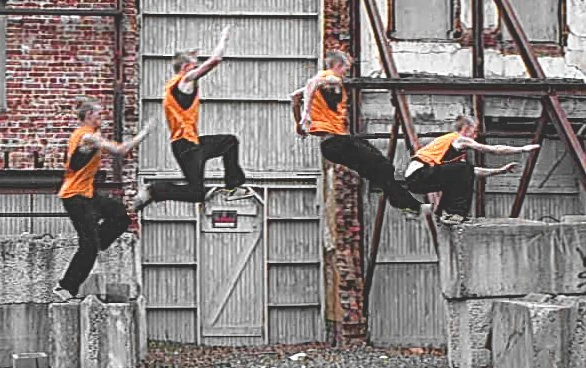The World's Parkour and Freerunning
Parkour was created
in France and the first person whose practiced it was David Belle,
Traceur and an actor best known for the films 13 District and 13 District
ultimatum. He is pattern for another traceur and everyone want be want like run
how him.
Rys.1. David
Belle
source: https://i.ytimg.com/vi/cjibtmSLxQ4/maxresdefault.jpg
The following link to
the interview with David Bell where you can see a few tricks.
https://www.youtube.com/watch?v=cjibtmSLxQ4
The main idea of Parkour is to get to your destination
in an unconventional way, e.g. when everyone goes in a normal manner by and
sees obstacles, try go around this. But Traceur (person who grown parkour)
jumps on or try jump them in a very
impressive way. In parkour we distinguish many styles of movement that are
developed by a traceur. Very often a traceur not only runs and jumps but he
also climbs on different buildings and monuments. It's dangerous but for a
traceur it's a place where he can get great skills and he can exercise flow.
Basics tricks are: one hand vault, two hands vault, monkey vault and roll.
Rys.2. One hand
trick
Source:
http://img01.deviantart.net/857c/i/2012/218/e/f/speed_vault_vector_by_kaka916kayz-d5a0nsj.jpg
Rys.3. Monkey Vault
Source: http://o4.fbl.pl/w640/fbl-2008/200812/27467315/monkey-vault.jpg
More advanced tricks are: balance, gap jump,
kong vault, cat vault, climb up, back flip and many more. Very performing arts are for me flag and half flag.
Rys.4. Flag
Source: http://m.ocdn.eu/_m/be657a0a8fa6e13519013e5a3627c22c,62,37.jpg
Rys.5. Kong Vault
Source: https://s-media-cache-ak0.pinimg.com/736x/6d/65/11/6d651180e32a22559f1131f311920d80.jpg
Rys.6. Jump
Source: http://vignette2.wikia.nocookie.net/parkour/images/c/cb/4508_1002576923124_1785871406_700_918771_n.jpg/revision/latest?cb=20100406145016
Very often parkours are an inspiration to create feature films. The best example was a film Yamakasi
and Yamakasi 2 where we can see a group of young people whose run and do
various stunts to do something for bigger objective. It's a very
interesting film for a person whose likes fast action and the French
type of humour. It’s a good film for a Friday
evening or for see in bigger package of friends in Saturday meeting.
Rys.7. Yamakasi
Source: http://1.fwcdn.pl/po/14/17/31417/7537330.3.jpg
Sometimes this type of film show young people whose develop their passions what great tricks and skills can be learned, expressing some involvement. Therefore, for persons whose want to rest from the
computer, was created a lot of schools where under the guidance of coaches can
improve technics and skils.
This sport is for everyone who want have fit and
durable body. Who want impressive overcome obstacles. If you like train hard,
you can be the best traceur in your district, town or country.
Questions:
1. Have you ever heard about Parkour and what do you think
about it?
2. Have you ever try do it? Which tricks are the most
liked?
3. How do you
think, whether the sport has a chance get more popularity?








